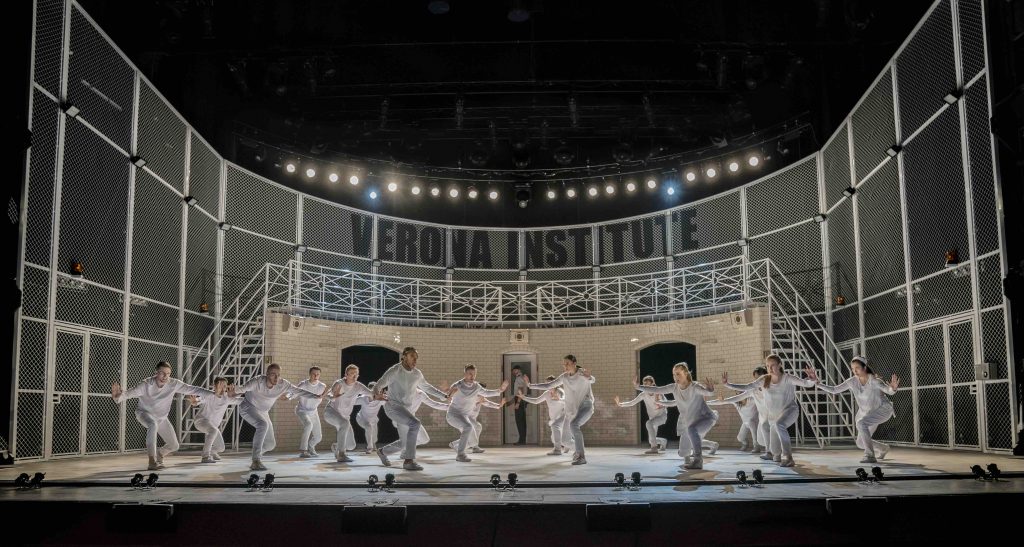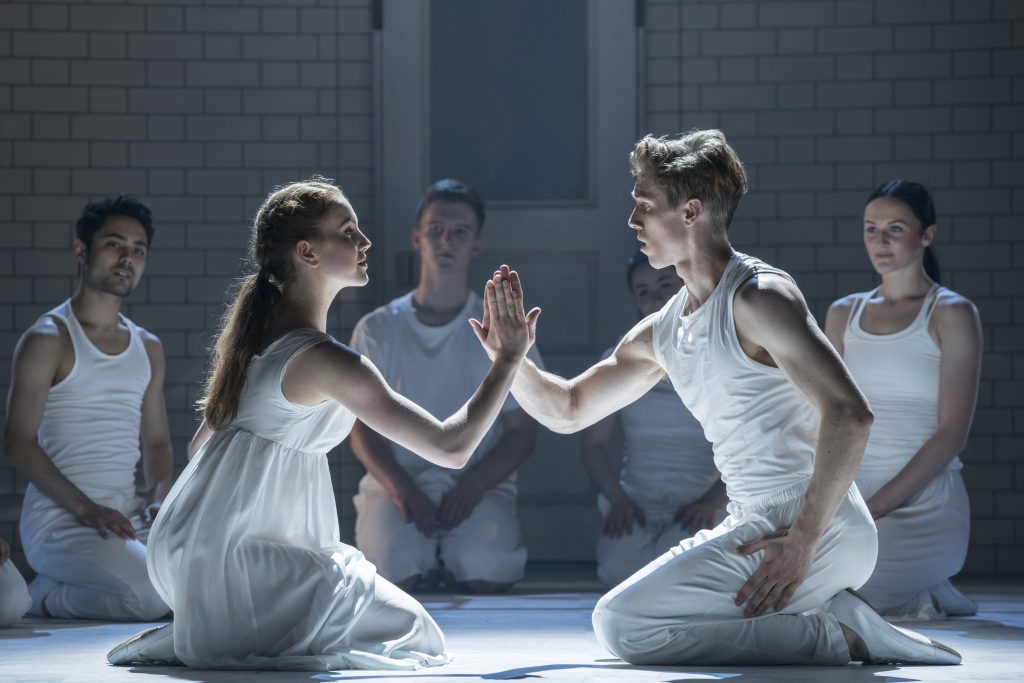Dance and theatre audiences’ love affair with Matthew Bourne shown no sign of waning and with this novel take on Shakespeare’s tale of the star cross’d lovers he has another hit on his hands.
It is indeed a new way of retelling of the Romeo and Juliet story, here with a young couple literally imprisoned in an institution in Verona (part mental asylum, part school but frankly the details do not matter). Boys and girls are kept apart, given drugs presumably to control their libido or just control them full stop, given robotic exercises and group therapy, and discouraged (brutally if necessary) from expressions of attraction and pleasure.
All of the action takes place on the one very simple set, a white tiled space with a boys and a girls gated entrance, a linking walkway and staircases, and fencing with flashing light alarms. Designed by Let Brotherston and lit by Paule Constable, this includes a large ominous central ceiling light, resembling a vast operating surgery lamp, which was lowered and raised at certain scenes, one including a disco glitter ball also emerging from its centre when Nurse (danced by Madelaine Brennan as a sort of compassionate prison chaplain) lets the kids off the leash.
Juliet is already locked away in the institute and the story really begins with Romeo being basically dumped there by his presumably famous politician parents. When the institute tries to rid themselves of this unruly teenager the parents just write a huge cheque to keep safely locked away.
Bourne uses three main styles of dance; controlled, robotic, repetitive ensemble work, for when the boys and girls are subdued and manipulated; apparently free-flowing, wild but still cleverly intricate and patterned movements for when the “inmates” have short bursts of freedom and then highly sensual duet work for the love scenes for Romeo and Juliet (and also other boy girls and boy-boy pairing). All work and are danced with a seeming effortless quality from a young cast. In those title roles Andrew Monaghan and Seren Williams were impossible not to watch, every movement and gesture sublime, yes, romantic, yet sensual but also gripping with portraying deeply disturbing mental health issues, including self harm and teenage suicide.
With our lovers, sex plays a key role in the choreography, as well it should with the story of teenage love and lust, (when they kiss and a crowbar would not get them apart) but also with other forms of sexuality and sexual obsession, including Tybalt a security guard with a mental health problem, danced with vigour by Danny Ruebens, who controls and abuses Juliet. Then we have Mercutio and Balthasar (danced by Ben Brown and Asher Rosenheim) being a delightful gay pairing but wo also have to be prised apart until, like Tybalt, death brings tragic consequences.
Of course, Bourne plays around not only with the plot, the characters but also Prokofiev’s score which is played by a small orchestra in the pit under the baton of Dan Jackson. It is an effective and beautifully played rearrangement of the Prokofiev.
As with other Bourne works, it is best to try to put the original ballet, if is based on part of the repertoire, or even a play or well-known tale, and approach it fresh and with an open mind. It avoids those cogs grinding few minutes trying to work out it relates to what you know from the title and also analysing rather than just enjoying.
I find one dormitory bedroom scene, with the boys and girls moving on, between, under beds reminiscent of a Lady Gaga video (for the song Alejandro) and then lo and behold as the curtain fell we had the auditorium filled with Bad Romance. I tried not smile but then I never did have a very good Poker Face.
Until June 22
Images: Johan Persson


